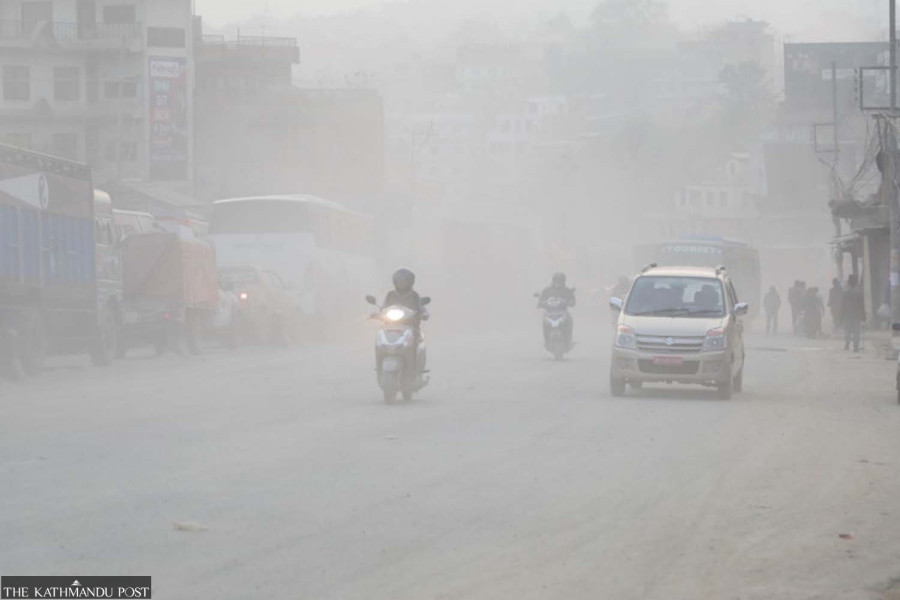Health
No caution even as toxic air takes heavy toll on public health
Pollution shaving 6.7 years off the lives of people residing in Siraha, and 6.2 years in Saptari and Rupandehi districts.
Arjun Poudel
Over 600 people with respiratory illnesses seek care at the Tribhuvan University Teaching Hospital on Tuesdays and Thursdays when the hospital runs its out-patient service.
The number of patients suffering from respiratory illnesses—pneumonia, bronchitis, asthma, and chronic obstructive pulmonary disease, among others—has risen significantly not only in this hospital but those across the country, according to health officials.
“Polluted air is the chief culprit for the rapid surge in the number of respiratory illnesses,” said Dr Niraj Bam, an associate professor at the Institute of Medicine, Tribhuvan University. “Along with respiratory illness, the toxic air has led to severe conditions like ulcers, cancer of the lungs and intestine, kidney disease, heart complications, high blood pressure and stroke.”
Of late, polluted air has been taking a huge toll on public health, throughout the globe.
A new report published on Thursday in The Lancet, a leading international medical journal, states that polluted air and high blood pressure are leading contributors to the global disease burden.
The report, “Global Burden and Strength of Evidence for 88 Risk Factors in 204 Countries and 811 Subnational Locations, 1990–2021: A Systematic Analysis for the Global Burden of Disease Study 2021,” shows that air pollution was the leading contributor to the global disease burden in 2021, making for eight percent of total disability-adjusted life years (DALYs), followed by high blood pressure (7.8 percent).
Likewise, smoking accounted for 5.7 percent, low birth weight and short gestation 5.6 percent and diabetes 5.4 percent of the burden.
Low birth weight, short gestation and unsafe water, sanitation, and handwashing (WaSH) were among the leading risk factors for the younger population up to 14 years, while for older age groups, metabolic risks such as high blood pressure, high body mass index (BMI), high blood sugar and high low-density lipoprotein (LDL) cholesterol had a greater impact.
Nepal’s air quality reaches hazardous levels several times a year, and the capital city often becomes the world’s most polluted metropolis. Doctors say particulate matter emitted from construction sites, wildfires, wood burning, agriculture activities, and dusty roads worsens air quality, threatening the health of hundreds of thousands of people across the country.
Most forests burn every year during the dry season. Vehicular and industrial emissions and the burning of agricultural residue make the air toxic.
A recent report by Save the Children also shows critical linkages between air pollution and multi-faceted hazards for children.
The report “Breathless Future: Unveiling the Impacts of Air Pollution on Children and Women in Kathmandu and Saptari” shows the systemic impact of air pollution on various aspects of children's lives. It also explores the effects of air pollution on women and underrepresented groups.
“Deteriorating air quality, outdoors and indoors, has exposed children and women to many health hazards—asthma, other lung conditions, coughing, skin disease, nausea, and headache,” reads the report. “Alarmingly, these conditions have led to increased cases of pregnancy loss, child organ underdevelopment, and a general decline in life expectancy.”
Studies carried out in the past show that polluted air has been shortening people’s lives. Nepali lives are being cut short by around five years, according to a report by the Air Quality Life Index (AQLI), which converts air pollution concentration into an impact on life expectancy. AQLI is a metric produced by the Energy Policy Institute at the University of Chicago.
Toxic air is deadlier than tobacco use and high blood pressure, which reduce life by 2.8 years and 1.7 years, respectively.
The reduction in life expectancy depends on where one lives—7.5 years in Mahottari, 7.4 years in Rautahat and Dhanusha, and 7.2 years in Sarlahi and Bara districts, the AQLI report said.
Likewise, the pollution has been shaving 6.7 years off the lives of people residing in Siraha, and 6.2 years in Saptari and Rupandehi districts.
Environment experts in Nepal said that worsening air quality has not only affected people’s health but also hit the economy and hindered overall development. Polluted air has for long been taking a huge toll on public health in Nepal but what’s alarming is that the authorities have not taken the issue seriously.
“We heard the government’s policies and programmes. There is no mention of the issue of air pollution,” said Bhusan Tuladhar, an environmental expert. “How can we mitigate the effects of air pollution, without addressing the problem?”




 17.12°C Kathmandu
17.12°C Kathmandu














